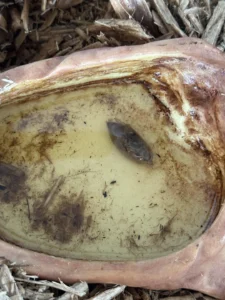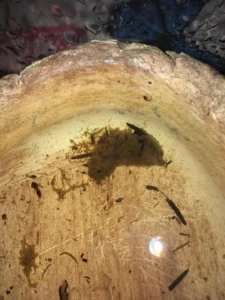Salamanders are quiet animals that often go unnoticed. They don’t make much noise, and they’re rarely seen during the day. But like every living animal, salamanders have to eat. And when animals eat, they also need to get rid of what’s left over. This leads to a simple but important question: what does salamander poop look like?
Salamander poop is dark, firm, and shaped like a small pellet or twisted coil. It often looks black or brown and may contain pieces of insects or other prey. You might also see a white paste nearby, which is a separate kind of waste called urate.
While not always easy to spot, it plays an important role in both the salamander’s health and the ecosystem around it.
What Healthy Salamander Poop Looks Like
If you’ve never seen salamander poop before, you might not notice it at first. It’s small, blends in well with dirt, and doesn’t smell very strong. But once you know what to look for, it’s easy to spot.
Most salamander poop looks like:
- A short, dark pellet or small coil
- Firm in texture, not runny
- Brown or black in color
- May contain insect parts, such as legs or wings
Sometimes it is shaped like a thin tube or slightly curved. In some cases, especially right after eating, it might be softer but still holds together.

If it breaks apart too easily or becomes watery, that could mean there’s a problem.
The size and shape may vary slightly between species, but healthy poop is always compact and solid.
The White Stuff Next to the Poop
Salamander droppings often come with a second, very different piece of waste: a small white or off-white blob. This is not poop. It’s something called urate.
Urate is how salamanders get rid of waste from their kidneys. While mammals pee out liquid urine, salamanders release a chalky white substance made from uric acid.
This helps them conserve water, especially in dry places or underground burrows.
Healthy urates are:
- White or slightly yellow
- Dry or slightly moist
- Pasty or chalky in texture
- Found next to or stuck to the poop
Some people mistake urates for fungus, leftover food, or even an illness. But they are completely normal. Their presence shows that the salamander’s kidneys are working the way they should.
Why Poop Shape and Size Can Vary
Not all salamanders leave behind the same kind of droppings. There are a few things that can change how their poop looks:
- Species: Bigger salamanders have larger droppings. For example, a tiger salamander will leave behind much bigger poop than a small red-backed salamander.
- Diet: If the salamander eats beetles, cricket shells, or other hard prey, you might see tiny fragments in the waste. Research on fire salamander diet diversity shows how different foods affect their digestive system.
- Habitat: Aquatic salamanders, such as newts or axolotls, may have softer poop, especially if it comes out underwater.
- Age: Young salamanders usually poop more often but in smaller amounts.
For example, a fire salamander that eats mostly worms may leave behind dark, smooth pellets. One that eats insects may leave poop with visible shells or legs.

Still, even with these differences, healthy poop always follows the same basic rules, it’s dark, solid, and well-formed.
Where Salamanders Go to the Bathroom
Salamanders don’t use special toilet areas like some mammals do. But they often return to the same safe spots over and over.
In the wild, they poop in places that are quiet and protected:
- Under rocks or logs
- Inside moist burrows
- Near the edge of streams or ponds
In tanks or enclosures, pet salamanders often choose a certain corner or part of the tank to go. This makes cleanup easier and also helps owners keep track of how often the salamander is pooping.
You may notice your salamander only poops near its favorite hiding spot or in one damp corner of the habitat.
How Often Do Salamanders Poop?
The timing depends on the species, age, diet, and temperature. In general:
- Small or young salamanders may poop every 1–2 days
- Adult salamanders may go every 3–5 days
- Large species may only poop once or twice a week
Salamanders digest food slowly, especially if they live in cooler conditions. If they haven’t eaten, they won’t poop for a while. That’s normal. But if too much time passes, or if they seem bloated or sick, it could be a sign of trouble.
Tracking poop patterns is one of the simplest ways to know if something has changed in the salamander’s health.
What Healthy Poop Should Look, Feel, and Smell Like
Here is a breakdown of normal salamander waste:
Color:
- Brown to black is normal
- Greenish or pale may point to a food issue or illness
Texture:
- Firm, but not rock hard
- Holds together, even when moved
Shape:
- Round pellet, soft coil, or straight tube
- May flatten slightly if stepped on
Smell:
- Mild or earthy
- Strong, sour, or rotting odors may be a warning sign
Poop that matches these descriptions usually means the salamander is eating well, digesting properly, and staying active.
Signs of Poop Problems
Like other animals, salamanders can develop problems with digestion. Here are a few signs of unhealthy poop:
- Watery or mushy poop – May suggest parasites or an infection
- Very pale or chalky brown poop – Could point to liver trouble or a poor diet
- Blood in the poop – May be caused by internal injury or illness
- No poop at all for many days – Might be a sign of impaction or constipation
In some cases, the problem may come from low temperatures, a dirty tank, or improper food. But if changes continue or get worse, it’s best to get help from a vet who knows amphibians.
What Causes Unhealthy Poop?
A few common problems can affect a salamander’s digestive system:
- Cold tanks: If the environment is too cold, digestion slows down and poop may stop entirely.
- Wrong food: Hard-shelled bugs or poor-quality feed can cause blockages or incomplete digestion.
- Stress: Loud noises, bright lights, or frequent handling may upset the animal and cause changes in poop.
- Dirty water: For aquatic species, unclean water can lead to infections or stomach issues.
Fixing these problems usually means checking the setup. Warmer temperatures, cleaner water, and better food can often get things back on track.
Cleaning Up Poop in Captivity
Salamander poop doesn’t last long in the wild. Insects, microbes, and weather break it down quickly. But in tanks and enclosures, poop needs to be cleaned up often to keep things safe and healthy.

To clean salamander waste:
- Use a spoon, plastic scoop, or tweezers to remove solid droppings
- Wipe away white urates at the same time
- Stir or replace dirty substrate if needed
- Wash your hands thoroughly afterward
Aquatic tanks may need a small siphon or net. Clean up once every day or two, or as soon as you see fresh waste. This helps prevent odors and disease.
What If You Can’t Find Any Poop?
Sometimes owners worry when they don’t see any poop in the tank. But there are a few reasons this might happen:
- The salamander may bury it under the substrate
- The poop may be small and easy to miss
- In aquatic setups, waste may break apart or get pulled into the filter
- Insects or cleanup crew animals might eat the waste
Even so, if it’s been more than a week without any poop and the salamander looks bloated or sick, it’s worth checking on them more closely.
What About Baby Salamanders?
Baby salamanders, also called larvae, have different waste habits. These young salamanders live in water, breathe through gills, and look like small fish. Their poop is:
- Smaller and more frequent
- Softer, often breaking up in water
- Harder to see, especially in busy tanks
As larvae grow and develop legs, their digestive system changes too. Their waste becomes darker and firmer. Once they complete metamorphosis and move to land, their poop looks just like that of an adult.
Is Salamander Poop Harmful?
In most cases, salamander poop is not dangerous to humans. But like all animal waste, it can carry bacteria or parasites. It should always be handled with care.
To stay safe:
- Wash hands after cleanup
- Don’t let children or pets touch the waste
- Avoid touching your eyes or face during cleanup
- Clean tools, dishes, or tanks regularly
These steps are simple, but they go a long way toward keeping both animals and people healthy. As noted in veterinary care guidelines, proper hygiene is essential when caring for amphibians.
Conclusion
Salamanders may be small and quiet, but their poop can tell us a lot. It shows whether they’re eating right, digesting well, and staying healthy. In the wild, it helps recycle nutrients and supports other life. In captivity, it’s one of the best signs that an animal is doing well.
Salamander poop is firm, dark, and shaped like a pellet or coil, often found next to a white paste called urate.
This natural waste is a sign that the animal’s body is working as it should. Watching for changes in shape, color, or smell can help spot trouble early and keep salamanders safe and healthy.
By learning to recognize healthy salamander poop, we learn more about these quiet creatures, and how to care for them in the best possible way.
Hi, my name is Ezra Mushala, i have been interested animals all my life. I am the main author and editor here at snakeinformer.com.

